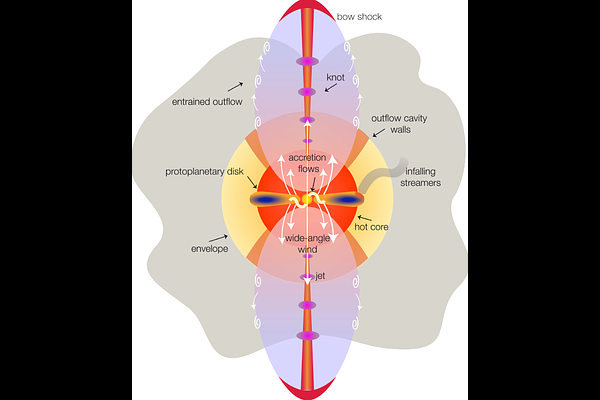JWST Observations of Young protoStars (JOYS): overview of program and early results

JWST Observations of Young protoStars (JOYS): overview of program and early results
E. F. van Dishoeck, Ł. Tychoniec, W. R. M. Rocha, K. Slavicinska, L. Francis, M. L. van Gelder, T. P. Ray, H. Beuther, A. Caratti o Garatti, N. G. C. Brunken, Y. Chen, R. Devaraj, V. C. Geers, C. Gieser, T. P. Greene, K. Justtanont, V. J. M. Le Gouellec, P. J. Kavanagh, P. D. Klaassen, A. G. M. Janssen, M. G. Navarro, P. Nazari, S. Notsu, G. Perotti, M. E. Ressler, S. D. Reyes, A. D. Sellek, B. Tabone, C. Tap, N. C. M. A. Theijssen, L. Colina, M. Güdel, Th. Henning, P. -O. Lagage, G. Östlin, B. Vandenbussche, G. S. Wright
AbstractThe embedded phase is a crucial period in the development of a young star. Mid-IR observations, now possible with JWST with unprecedented sensitivity, spectral resolution and sharpness are key for probing many physical and chemical processes on sub-arcsecond scales. JOYS addresses a wide variety of questions, from protostellar accretion and the nature of primeval jets, winds and outflows, to the chemistry of gas and ice, and the characteristics of embedded disks. We introduce the program and show representative results. MIRI-MRS data of 17 low-mass and 6 high-mass protostars show a wide variety of features. Atomic line maps differ among refractory (e.g., Fe), semi-refractory (e.g., S) and volatile elements (e.g., Ne), linked to their different levels of depletion and local (shock) conditions. Nested, stratified jet structures consisting of an inner ionized core seen in [Fe II] with an outer H2 layer are commonly seen. Wide-angle winds are found in low-J H2 lines. [S I] follows the jet in the youngest protostars, but is concentrated on source when more evolved. [Ne II] reveals a mix of jet shock and photoionized emission. H I lines measure accretion, but are also associated with jets. Molecular emission (CO2, C2H2, HCN, H2O, ..) is cool compared with disks, and likely associated with hot cores. Deep ice absorption features reveal not just the major ice components but also ions (as part of salts) and complex organic molecules, with comparable abundances from low- to high-mass sources. A second detection of HDO ice in a solar-mass source is presented with HDO/H2O ~ 0.4%, providing a link with disks and comets. A deep search for solid O2 suggests it is not a significant oxygen reservoir. Only few embedded Class I disks show the same forest of water lines as Class II disks do, perhaps due to significant dust extinction of the upper layers [abridged].